The grandma housecoat was one of the most popular garments of socialism, even though it only gave women a semblance of equality
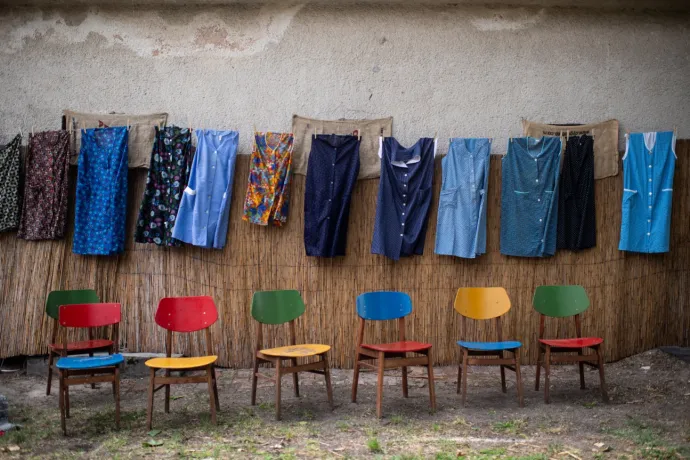
The village of Szatymaz, a few kilometres from Szeged, realised that if they used the word 'grandma housecoat' ('otthonka' in Hungarian) as a catchphrase in addition to their famous apricot, it might attract crowds of people eager to see the wonders of the half-century-old nylon dresses flapping in the wind. We took a good look at the innovative exhibition this summer – it provided a good excuse to track down an iconic piece of clothing that is just about to fade away. We also looked at what collective memory does with it and why it became the 'plastic greenhouse' of the human body.
A light summer breeze wafted through the nearly one hundred grandma housecoats that decorate the walls and the outbuilding of the cultural centre in Szatymaz. It was Friday and lunchtime, the Apricot Festival was about to begin in the afternoon, and this year the organisers added an outdoor grandma housecoat exhibition to the programme, complete with a fashion show.
The village of 4,700 inhabitants in the Southern Great Plain has long been famous for its apricots (formerly its grapes). If you think about the clothes our elderly relatives used to wear when sweating while making apricot jam, you can already make the connection between apricots and grandma housecoats – it is no coincidence that similar associations filled the mind of Attila Kémeri, the mastermind behind the idea, who is in charge of communication for the village.
Today, it is rarely seen on anyone and only those over the age of 80 still wear it, but in its heyday, especially in villages and small towns, there was hardly a household without at least one of these nylon housecoats.
„Despite the fact that many people wore it as a protective garment at work, the grandma housecoat was a garment designed for home use, and was a symbol of good housekeeping and the socialist morality of every 'decent' housewife, and at the same time of her apparent equality”, historian Izabella Agárdi wrote in her study of grandma housecoats, entitled „The nylon grandma housecoat – the legacy of an empire”.
Why, during the years of Goulash Communism, did so many women insist on one of the most successful products of the Socialist garment industry? – we put the question to both the Satymaz organisers and the historian. It turned out that the grandma housecoat is much more exciting than it appears.
A modernised apron, the Socialist masterpiece of polyester manufacturing
„The grandma housecoat was a sign of a generational difference: it was worn by women who became married, working women during socialism. For them, the apron was too outmoded, but not the grandma housecoat, as it became a modernised version of the apron,” Izabella Agárdi explained to Telex. Strange as it may seem in retrospect, in the 1960s and 1970s, the grandma housecoat was considered as cool and comfortable as, say, a pair of Birkenstock slippers today.
Its cult status is well illustrated by the fact that there were garment factories that wanted exclusive rights to the name ‘grandma housecoat’. Of course, it didn't just become so popular by chance – let us not forget that this was in the middle years of state socialism – its triumph was linked to the rise of polyester, which was the cutting edge of modernity at the time. The boom in man-made fibre production in Hungary began in the 1960s and reached its peak in the 1970s. In the textile industry, the aim was to increase the use of plastics, and as part of this, the so-called polyester programme was launched in 1965-66.
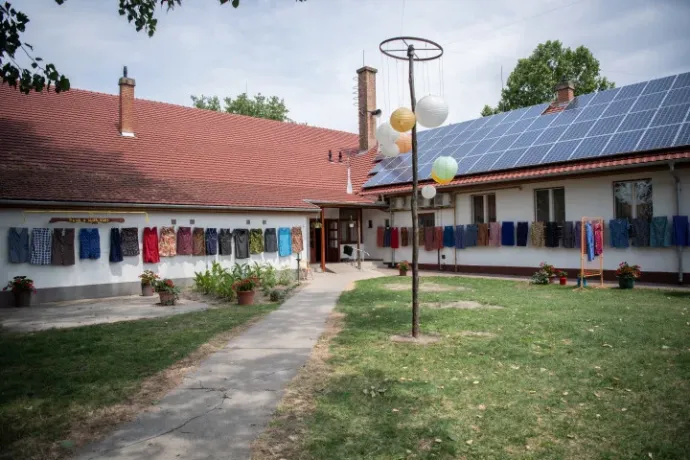
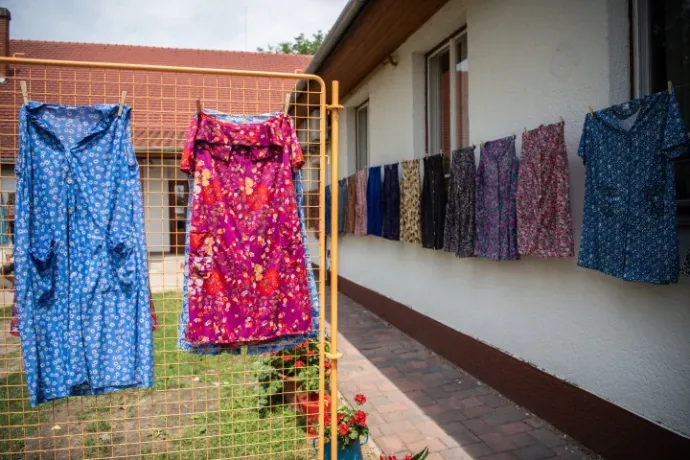
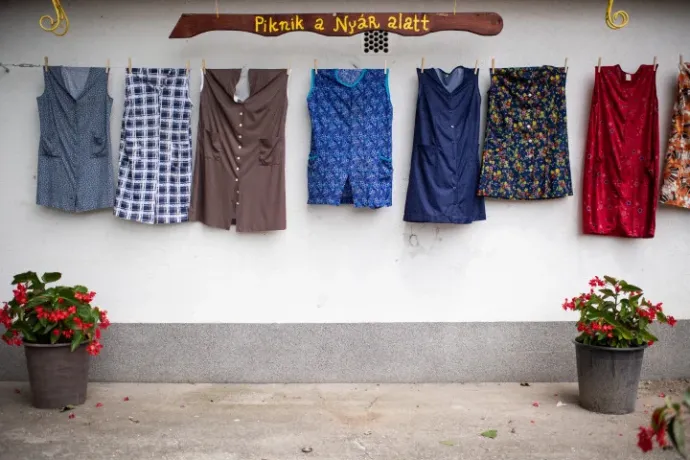
As a result, nylon grandma housecoats flooded the country from the late 1960s onwards.
As far as grandma housecoats were concerned, as in so many other things, women were given a semblance of freedom and autonomy: anyone could sew their own grandma housecoat from patterns published in newspapers, but they could also be bought from ready-to-wear shops and markets.
It was not only popular in our country, but also in the other Comecon countries; in fact, grandma housecoats were also produced in West Germany and Portugal; but it was in the socialist bloc that they really gained popularity.
But how did so many grandma housecoats end up in Szatymaz in 2022? After Attila Kémeri hatched the idea around May, and word spread around the area that they were looking for grandma housecoats, donated items started arriving from Szatymaz and the surrounding area, and even from as far as Sopron and Ravazd in Győr-Moson-Sopron County. Initially, they were expecting 10-15 items, but now they have more than 100 grandma housecoats: mostly with tiny floral patterns, but plenty of non-figurative ones too: polka dots, spirals, geometric, stripes – in cheerful, but by no means too garish colours.
It turned out that the grandma housecoat was considered a very practical garment by women: its large pockets could hold a lot of things, its sleeveless cut left a lot of freedom for arm movement, if it got wet it washed and dried quickly, no ironing was needed, and the buttons made it easy to put on.

The transparent, smelly grandma housecoat for summer
Humorist Tibor Bödőcs once called grandma housecoats, „the plastic greenhouse of the human body”, and the expression is apt in more ways than one: the thin plastic wrapped around the wearer's body, which in summer could swell underneath it like tomatoes growing in a 50 °C greenhouse.
The collective memory of Szatymaz also mentions an oddity in this respect: in summer, women wore their grandma housecoat only with panties under it at best, and the thin polyester was rather transparent (we checked this at the Szatymaz exhibition).
„We'll put on a pair of long panties under it, anyway – that's what Granny always said”
– Ilona Bárkányi Feketéné, co-curator of the exhibition and director of the Cultural Centre that houses the grandma housecoats says, illustrating this phenomenon. It is clear that the people of Szatymaz are well prepared: at the mention of underwear, her colleague runs into the building and five minutes later returns to the exhibition with the aforementioned long panties, better known as long-legged panties.
It is also a point worth mentioning here that in the sixties and seventies, everyone was covered in as much body hair as nature intended – and from then on, it is up to the imagination to decide how to finish this train of thought.
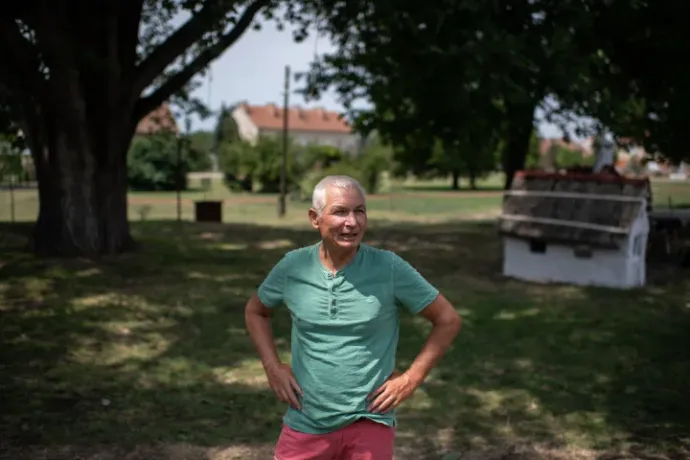

They even wore it to church, until it wore out
A grandma housecoat might have been a sexy thing to wear in summer, but in winter it certainly was not – thanks to its constant companion, the typically baggy tracksuit bottoms. As they were worn as work clothes for the home, and their function was to protect the clothes underneath, they often tore, but the women of the time were not squeamish, they sewed them even several times, and if, say, only white thread was available they sewed the blue floral grandma housecoat with it and next time perhaps with brown thread. Just as the thread was not something to show off with, it was not acceptable to buy a new grandma housecoat until the previous one was worn out – it was considered a waste of money, and it was not in keeping with socialist morals to discard a garment prematurely. That was why they were often worn until they were completely worn out.
We also see this in Szatymaz, where most of the clothes were not brought or sent by the original wearer, but by a family member. And this shows – according to Izabella Agárdi – that this is one of those relics of socialist realism that have been strangely ennobled.
„Family members in the present, for example, don't remember the unpleasant plastic and body odour, only that their mother or grandmother was wearing it, so it's their smell that comes to mind – hence the image of familiarity.”
– the historian explains.
„According to nostalgia theories, however, one must be cautious about the memory of totalitarian regimes: in such cases, the unpleasant is absurdly combined with the pleasant, the world of emotions mixed with critical evaluation.”
As with many other types of clothing, there was a hierarchy among grandma housecoats: there were church-going, more ceremonial grandma housecoats (mainly covered in abstract, modern designs), while the small floral ones were more for everyday wear. The very elderly women did not even allow themselves that much deviation, and wore only dark colours. Although we didn't see any of them at the exhibition, but from what we're told there were also girls' grandma housecoats – it must have been a great experience to take off the compulsory nylon school cloak after school and slip into the nylon grandma housecoat. And then spend half your life in it.
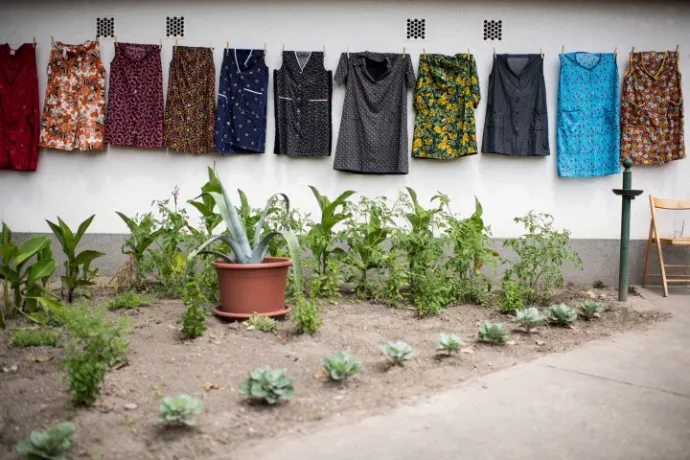

The original Hungarian term for grandma housecoat, ('otthonka') with a diminutive suffix is interesting as it may sound like a term of endearment, and another researcher, ethnographer Zsófia Frazon, says that „it is a perennial question whether the endearment was aimed at the dress itself or the wearer, the woman at home”. Either way,
the grandma housecoat is a symbol of domestic labour, of women's unpaid domestic work, and „just as the grandma housecoat is disappearing from our sight, we are blind to and in debt of the recognition of women's domestic labour – at the societal level anyway.”
– the ethnographer writes.
The grandma housecoat exhibition in Szatymaz also indicates that we have perhaps moved further away from this garment: it has been the subject of cultural history treatises and studies, and in the 2000s it was already considered a museum piece, which, according to Agárdi, „although it remains part of the material world of the present, it needs to be preserved. It is as much a part of the museum canon as the old Sokol radios of the Soviet era or the plastic objects designed by craftsmen at the time,” according to the historian. The grandma housecoat was out of date by the 1990s, anyway, although, as we wrote, it is still worn sporadically in some places.
The people of Szatymaz are planning a travelling exhibition, and two municipalities have already registered. And how long will the exhibition be open in its original location? „It came spontaneously, and it will be what it will be. For a while, surely” the organiser said.
If you enjoyed this inside look at part of Hungarian culture, and want to make sure you don't miss similar content in the future, subscribe to the Telex English newsletter!
The translation of this article was made possible by our cooperation with the Heinrich Böll Foundation.